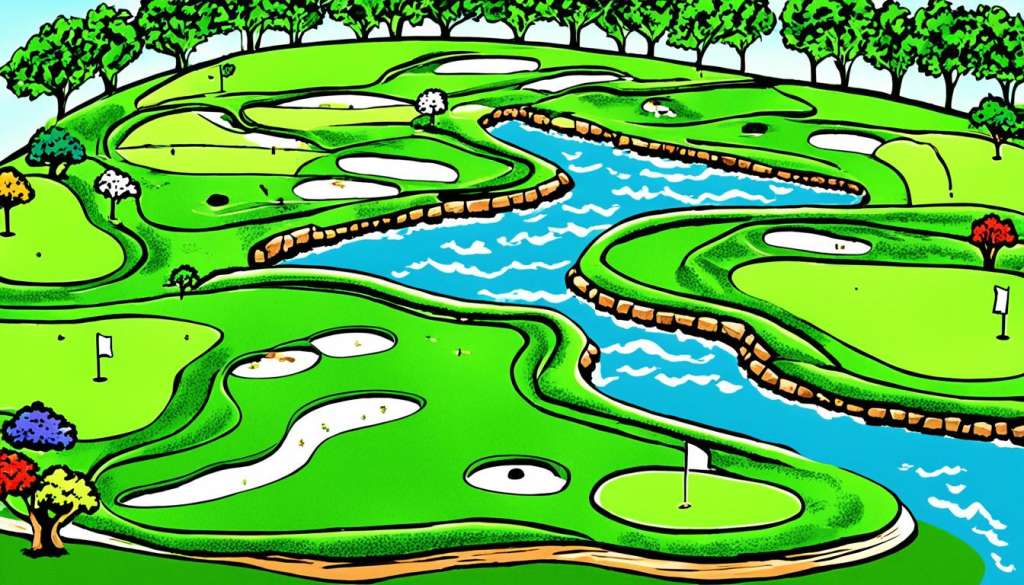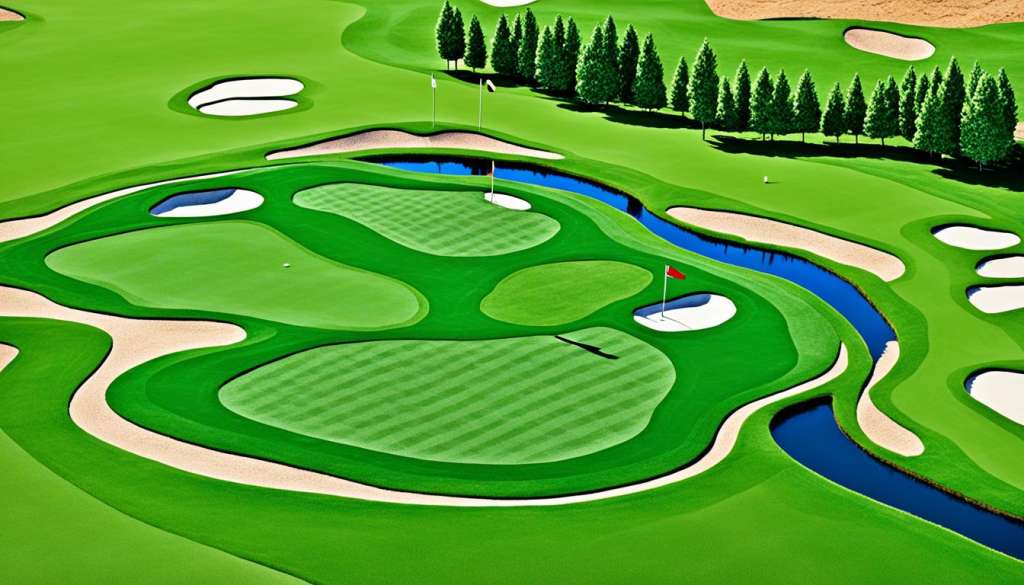Get ready to explore the exciting world of golf course design. This guide will show you the key elements that make a golf course fun and challenging. You’ll learn how the placement of tee boxes and the shape of greens affect the game.
Golf course design is an art that combines nature with clever challenges. PGA pros work with designers to make sure each hole is tough yet fair. This guide will reveal how designers balance difficulty with fun, creating unforgettable golfing experiences for everyone.
Learning about golf design will make you appreciate the game more. You’ll see how every part of the course, from hazards to fairway slopes, affects the game. Each element is important for the golfer’s journey from tee to green.
Introduction to Golf Course Architecture
Golf course architecture has changed a lot since the game started. The design of courses has evolved with changes in playing styles, technology, and how we think about the environment. Today, courses mix old traditions with new ideas, making them fun and challenging for all players.
Historical Evolution of Golf Course Design
Golf started in the 13th century in the Netherlands. By the 1740s, it became popular in Scotland. The first U.S. golf club opened in 1888 in Yonkers, New York. Early courses were simple, following the natural shape of the land.
As golf grew, so did the design of courses. They started to include strategic elements and look good. This made the game more interesting and challenging.
Key Principles of Modern Course Architecture
Today, course design focuses on making courses diverse and fun. Designers think about the land’s shape, how water moves, and being kind to the environment. They want to challenge good players but still let beginners have fun. Important parts of modern design include:
- Strategic placement of hazards
- Varied hole lengths and shapes
- Multiple tee positions
- Green complexes with subtle contours
- Incorporation of natural features
The Role of PGA Professionals in Course Design
PGA professionals have become more important in designing courses. They bring their knowledge of the game to the design process. They work with architects to make courses that are tough but fair for everyone.
This teamwork makes sure courses are great for both casual and serious players.
| Aspect | Traditional Design | Modern Design |
|---|---|---|
| Layout | Simple, follows natural contours | Complex, strategically shaped |
| Hazards | Minimal, mostly natural | Numerous, strategically placed |
| Green Complexes | Basic shapes, mild slopes | Intricate designs, multiple pin positions |
| Environmental Focus | Limited consideration | High priority, sustainable practices |
Tee Box Placement and Design
Tee box design is key to a great golf course. Where tee boxes are placed affects the game, making it more fun or challenging. Let’s look at how tee box placement and design make a course stand out.
Strategic Considerations for Multiple Tee Positions
Having multiple tee positions is vital for all skill levels. It lets beginners, intermediate, and expert players start from different spots. This makes the game more enjoyable and adds strategy.

Incorporating Natural Terrain into Tee Box Design
Using the natural terrain in tee box design is a top feature. Designers work with the land to create beautiful and eco-friendly tee areas. This method protects nature and challenges golfers in new ways.
Impact of Tee Placement on Player Strategy
Where tee boxes are placed changes how players tackle each hole. A smartly designed tee box makes players think about their shots more. They must consider distance, hazards, and where the ball should land. This makes the game more exciting and varied, so every round is different.
| Tee Position | Distance (yards) | Strategic Implications |
|---|---|---|
| Forward | 250-300 | Easier approach, suitable for beginners |
| Middle | 350-400 | Balanced challenge, ideal for intermediate players |
| Back | 400-450+ | Increased difficulty, targets advanced golfers |
Golf course architects think deeply about tee box design. They aim to make the game fun and memorable for all players.
Fairway Contouring and Shaping
Fairway design is key to a strategic golf layout. It shapes how players tackle each hole, making it vital in course landscaping. A well-designed fairway blends with the land and offers unique challenges.
Golf course architects use many techniques for engaging fairways. They think about drainage, playability, and looks. Subtle undulations and mounds affect ball roll and shot choice. This makes the game more challenging and requires smart thinking.
The width and shape of fairways are crucial in course strategy. Wide fairways are easier, while narrow ones require precision. Some courses have split fairways, offering different paths to the green. This adds a risk-reward element, making the game more exciting.
| Fairway Feature | Purpose | Impact on Play |
|---|---|---|
| Undulations | Create varied lies | Challenges shot selection |
| Mounds | Influence ball roll | Affects approach strategy |
| Width variation | Control difficulty | Rewards accuracy |
| Split fairways | Offer multiple routes | Adds risk-reward element |
Good fairway design suits all skill levels. It challenges experts and is playable for beginners. This balance makes the course fun and engaging for everyone.
Green Complexes: The Heart of Golf Course Design
Green complexes are the key part of golf course design. They blend skill and strategy, testing players with slopes, undulations, and pin placements. Let’s dive into how these elements shape your golf course strategy.
Slope and Undulation in Green Design
The shape of a green can affect your putt. Designers use slopes and undulations to test your skills and precision. These subtle and pronounced features turn each putt into a puzzle.

Pin Placement Options and Strategic Implications
Where the pin is placed changes your approach strategy. Course managers move the hole locations to keep the game exciting. A pin near a bunker requires a different strategy than one in the center.
Your ability to adapt to these changes can greatly affect your score.
Approaches and Surrounds: Creating Challenging Shot Options
The areas around the green offer many shot options. Designers add features like swales and closely mowed fringes. These elements make you choose between a pitch, chip, or putt, adding to your decision-making.
| Green Complex Feature | Impact on Strategy |
|---|---|
| Severe Slopes | Forces precise landing areas |
| Multiple Tiers | Increases importance of approach shot accuracy |
| Tight Pin Locations | Rewards bold play, punishes errors |
| Varied Surrounds | Tests short game versatility |
Understanding green complexes is key to a good golf course strategy. By thinking about slope, pin placement, and the area around the green, you can make better decisions. This leads to lower scores and a more fun game.
Hazard Design: Bunkers, Water Features, and More
Golf hazards are key to making a course challenging and fun. They include bunkers, water features, and more. These obstacles test players’ skills and how they make decisions. Architects aim to make the course fair but still challenging for all players.
Bunker design is a special art. Sand traps vary in shape and size, each with its own purpose. Some catch wayward tee shots, while others protect the greens. The design of bunkers affects how players move through the course.
Water features add beauty and challenge to golf courses. Lakes, ponds, and streams look great and are tough obstacles. Designers place water hazards carefully to make the game fun but not too hard.
| Hazard Type | Purpose | Design Considerations |
|---|---|---|
| Fairway Bunkers | Penalize inaccurate tee shots | Placement, depth, visibility from tee |
| Greenside Bunkers | Protect greens, challenge approach shots | Shape, depth, lip height |
| Water Hazards | Create risk-reward scenarios | Location, size, shoreline design |
| Natural Hazards | Incorporate existing landscape features | Integration with course layout, playability |
Other hazards like trees, rough, and natural areas add to the course’s charm. They help frame holes and make the game more interesting. The goal is to blend these hazards into the course design for a great golfing experience.
Golf-Specific Design Features Guide
Creating a golf course design guide is all about making sure players of all skills have fun. It’s about focusing on key features that make the game enjoyable. These features help with course playability and cater to different abilities.
Essential Elements of a Comprehensive Design Guide
A good golf course design guide has several important parts:
- Hole layouts that offer strategic options
- Hazard placement for challenge and visual appeal
- Green complexes with varied contours
- Tee box positioning for multiple skill levels
- Fairway shaping to influence shot selection
Balancing Challenge and Playability
Finding the right balance between challenge and playability is key. Designers need to think about:
- Varied hole lengths to test different clubs
- Risk-reward opportunities for skilled players
- Generous landing areas for beginners
- Multiple routes to the green
Incorporating Skill-Level Features
To make courses fun for players of all abilities, architects add features like:
| Skill Level | Design Features |
|---|---|
| Beginner | Wide fairways, minimal hazards, large greens |
| Intermediate | Strategically placed bunkers, moderate rough |
| Advanced | Narrow landing zones, challenging approach shots |
By using these golf-specific design features, courses can offer a great experience for golfers at all levels. They keep the game challenging yet playable for everyone.
Environmental Considerations in Golf Course Architecture
Golf course design is changing to focus on taking care of the environment. Sustainable golf design is making courses better for nature. It keeps natural habitats safe while making the game fun and challenging.
Sustainable Design Practices for Modern Courses
Modern golf design uses eco-friendly materials and methods. Designers pick plants that need less water and upkeep. They also use recycled materials for building. These steps lower the environmental impact of golf courses but keep them beautiful and fun to play.
Integrating Local Ecosystems into Course Layouts
Putting local ecosystems into golf courses is important today. Designers aim to keep natural areas safe. They make paths for wildlife and keep native plants. This helps local wildlife and makes the game better by connecting players with nature.
Water Conservation and Management Strategies
Water is key in golf course design. Smart watering systems use weather info to water wisely. Designers pick grasses that don’t need much water. They also make water features that are good for golfers and wildlife.
| Water Conservation Strategy | Benefits |
|---|---|
| Smart Irrigation Systems | Reduces water usage by up to 30% |
| Drought-Resistant Grasses | Requires 50% less water than traditional turf |
| Rainwater Harvesting | Provides natural irrigation source |
By focusing on the environment, golf course architects make courses that are good for players and the planet.
Player Strategy Integration in Course Design
Golf course design shapes your strategy and decision-making on the links. Architects create layouts that make you think deeply about each shot. They help improve your golf strategy and course management skills.
Hazards like bunkers and water features add drama and demand precision. They test your nerve and shot-making skills. You must decide between bold moves and safer options.
The shape of the fairway affects your tee shot choices. Wide areas invite bold drives, while narrow ones require accuracy. Undulations change how the ball rolls and where you stand, making each shot unique.
Green complexes are the ultimate test of your decision-making. They have slopes and tiers that need careful club and shot selection. The pin’s position makes you balance bravery with caution.
- Multiple tee options cater to different skill levels
- Varied hole lengths challenge club selection
- Recovery shots from rough or trees test creativity
Course designers aim to create a diverse set of challenges. This variety keeps you engaged and forces you to use every club in your bag. By adding strategic elements, architects reward good course management with lower scores.
Technology and Innovation in Golf Course Design
Golf technology has changed how courses are designed, maintained, and played. It brings new tools from the planning stage to the actual game. These tools are making a big impact on building and enjoying courses.
3D Modeling and Virtual Reality in Course Planning
3D course modeling lets designers see their ideas before they start building. You can walk through the course in virtual reality, checking out the layout and hazards. This technology makes courses more strategic and pleasing to the eye, while also saving time and money.
Advanced Irrigation and Turf Management Systems
Smart turf management systems are now used to keep courses green. They use sensors to check soil moisture, weather, and grass health. These systems use water wisely, cutting down on waste and keeping the fairways perfect all year.
GPS and Digital Course Guides for Enhanced Player Experience
GPS course guides have changed how we move around the course. With accurate yardages and hole layouts at your fingertips, you can plan your shots better. These tools help speed up play and lead to better decisions on the course.

